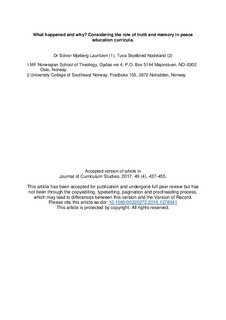What happened and why? Considering the role of truth and memory in peace education curricula
Journal article, Peer reviewed
Accepted version
Permanent lenke
http://hdl.handle.net/11250/2563105Utgivelsesdato
2017Metadata
Vis full innførselSamlinger
Sammendrag
This paper is an exploration of challenges arising in the interplay between a standardised peace education curriculum and a localised post-conflict setting. Drawing on interview data from two Kenyan schools, the paper explores the reception of peace education initiatives implemented in Kenya following the post-election violence of 2007/2008 through the voices of teachers and pupils. The analysis identifies two patterns emerging from the pupils’ point of view; firstly an engagement with narratives of conflict addressing what happened during the outbreak of violence, and secondly an awareness of collective narratives of the past, centred on the question of why the conflict broke out. The data identifies a gap between the knowledge and perspectives of the pupils, and the level of engagement by the curricula and teachers in the same issues. Finally, the paper explores some implications of these diverging needs and perspectives in relation to the design and implementation of peace education curricula, particularly in relation to providing sufficient support for the teachers.
